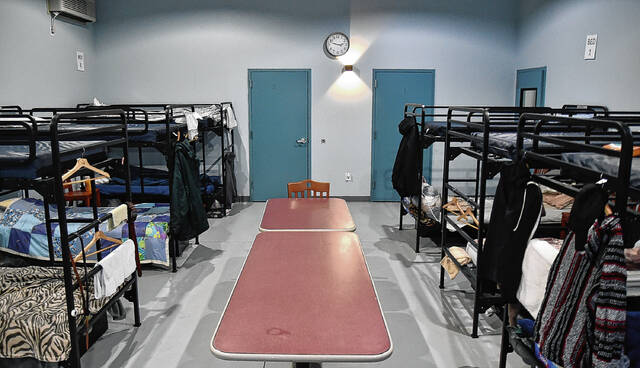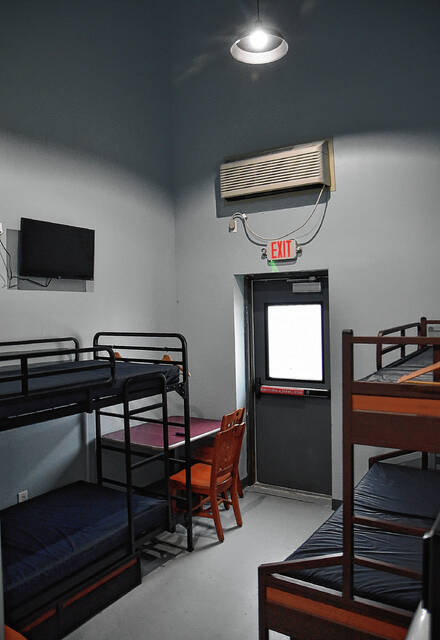Since Anchor House Family Assistance Center was established in 1990, the focus had been on providing temporary housing for homeless families with children.
Individuals needing temporary shelter didn’t have a place to go, and it was tough for Anchor House staff to have to turn them away.
In February 2021, though, the Anchor House East Shelter opened at 326 Dupont Drive, providing space for men, women and families to stay until they could find stable employment and housing.
In the first year, the facility has served more than 285 clients and provided 4,645 nights of stay. New staff positions were created, clients were given an opportunity to be interns at the shelter and earn money and a Pathways Program was implemented.
“I think it makes an incredible impact on the community,” Executive Director Megan Cherry said. “It’s a big blessing to the community to have that as a resource, and I think that it’s extremely important to be able to finally not turn someone away.”
Anchor House annually does a point in time count, which involves traveling around the county to determine the number of homeless people. The most recent count was memorable.
“The last several years, we’ve found a few, but this year, we found zero,” Cherry said. “I believe that to be because we are housing that population now that was before out in the elements and didn’t have that place to go. It has been really nice to have this available to the community.”
Opening a second shelter for emergency housing needs was made possible by a $50,000 COVID-19 Economic Relief Initiative Grant from Lilly Endowment Inc. and Indiana United Ways and financial support from the Community Foundation of Jackson County, Royalty Companies and private donors.
The facility, which can accommodate up to 46 people, opened much earlier than anticipated, Cherry said.
“After some discussions, because of the cold weather season that we were in, no one wanted to see anyone out in the elements,” she said. “There really wasn’t that many other options at that time, so we thought, ‘What is the minimum amount we can do to get the doors open to get people out of the cold?’”
Initially, the East Shelter was only open from 6 p.m. to 10 a.m. with one staff member working the first eight hours and another one coming in for the final eight.
Money via fundraising and grants allowed staff to be added, and in May 2021, it became a 24-hour facility.
Dustin Vice started as a lead staff member in February and later was promoted to program director, and Andrew Barker joined as program case manager.
In September, a client internship program was created, and a Pathways Program was implemented.
Cherry said the intern program stemmed from a couple of clients at the East Shelter who had really stepped up and were allowed to work there.
“We started to notice that those are the people that have the best rapport with the clients,” she said. “We usually identify them once they’ve started to complete some of the things and we start to see people stand out and take leadership in their rooms, in their dorms, and we pick them up from that and put them in an intern position as a volunteer.”
Through volunteering in the pantry, helping with cleaning and assisting staff, some transitioned to a paid internship position.
“So they are actually earning money, they’ll save their money with us just like everybody else, but they still continue to work the program like everyone else,” Cherry said.
Vice said for some of them, they are trying to get health issues resolved or don’t have two forms of identification to have a job, so interning at the shelter allows them to work in the meantime.
Cherry said she modeled it after a program at Wheeler Mission Ministries in Bloomington.
“A lot of them want to give back because they are so grateful to be here, so if we can find interns that want to do that, then it’s even better because we can pay them and they enjoy helping people,” she said.
Vice said newer clients can relate to the interns because they are going through the program, too.
“Sometimes, people come in and they don’t know how to take a certain way that you deliver something, and (the interns) are able to step up and say, ‘Listen, that’s just how it is for everybody. You’ll see the genius in it later,’ and they always do,” he said. “It’s good for the communication factor. We’re not always here, so it takes them longer to get to know us than it is to get to know them.”
Currently, Anchor House has three client interns, and Cherry said they may add a fourth to work at both the East Shelter and the facility at 250 S. Vine St.
The Pathways Program is followed by everyone who becomes an Anchor House client.
When a person arrives at the East Shelter, staff members evaluate them for about three days, letting them come down from a crisis mindset and learn about the requirements of the program.
“If they feel like that’s a good fit for them and we feel like they are a good candidate, then we enroll them,” Cherry said.
Then they begin the 12-week program that offers assistance in resources, community referrals, life skills education, financial education, nutrition education, parent education for families, a savings program and finding permanent housing.
They spend time in the men’s or women’s dorm or one of the three family rooms at the East Shelter, and as they move through the program, the Vine Street campus is used as an incentive and they will move into one of the seven apartments there until finding permanent housing.
For some, it takes the full 12 weeks. Others may spend a little less or a little more time at Anchor House.
“There are people that can get to work quickly and save money and get moved out,” Cherry said. “It really all depends on their background. Sometimes, finding housing is challenging based on their criminal background or previous evictions or just availability of affordable housing in general. All of those things come into play, but we have the framework of 12 weeks.”
Anchor House used to have an eight-week program that was focused on clients getting a job and a place to live and moving on. Cherry said they wanted to be a little more holistic in looking at the root cause of why a person is there.
That includes helping them with other needs, including insurance, financial assistance, mental health resources and substance use treatment.
There’s also a socialization course that has components of anger management, stages of change, communication skills and examining relationships. That’s done in a group setting.
In the near future, Anchor House plans to add a Narcotics Anonymous class.
“Just trying to get them the most resources they can, not just hurry up and work, hurry up and get out and get a place to live because that’s not really sustainable if they have an underlying health condition or something,” Cherry said.
Since the Pathways Program began, 50 people have participated. Half of them have graduated and moved on to their own place, while others are still enrolled.
After a client leaves Anchor House, staff members maintain a relationship with them to monitor their success. That’s scored through a self-sufficiency matrix. Cherry said more than 80% of the clients served moved from crisis to safe mode.
If someone decides after the initial evaluation period that they don’t want to enroll, Cherry said staff will look into other resources to find them another place to go.
“We really don’t want to get in the habit of just being a warehouse for people to just live. We want to be more of an agent of change so we’re able to reestablish their lifestyle and reestablish stability,” she said.
New this year, a winter contingency plan was offered to individuals who didn’t want to enroll but needed shelter from the elements. That will end this month when warmer weather arrives.
Both Cherry and Vice said it’s rewarding to see a person go from emergency mode to crisis mode to safe mode.
“All the hard times, the stuff that you go through with people … it makes it all worthwhile for me, puts things in perspective. That’s where you see the payoff because you are there with them,” Vice said.
“Really, more than anything, we become their family, and so you obviously take pride in your family and their accomplishments,” Cherry said. “The No. 1 reason we see people come through here is lack of support, so when they don’t have that support system and they come in here and we helped build that around them, then a lot of these people become our family. We love them like our own family.”
In the second year of the East Shelter, Cherry said the goals are to continue to expand programming and get the community involved in what Anchor House is doing.
While the focus has been on the interior of the building, Vice said they will work on making the exterior more of a home setting, including landscaping, a garden and playground equipment.
“We really had to concentrate this (past) year on the inside to get it all together,” he said. “We want to take the spring and the summer to try to make it even more of a welcoming atmosphere for people.”
Anchor House East Shelter
Where: 326 Dupont Drive, Seymour
Who: Jackson County families and individuals with emergency housing needs
Hours: Open 24/7; intake hours are 6:30 to 8:30 p.m. seven days a week
Information: 812-522-9308
Anchor House Family Assistance Center and Pantry
Where: 250 S. Vine St., Seymour
Who: Apartments are available for Jackson County homeless families with children, and the food pantry is available to the community
Hours: Pantry days are 10 a.m. to 3 p.m. Mondays and from noon to 5 p.m. Thursdays
Information: 812-271-1252 (shelter program director) or 812-271-1253 (pantry director)
For other information about Anchor House, email [email protected] or visit anchorhouseshelter.org or facebook.com/ahfamilyassistancecenter






